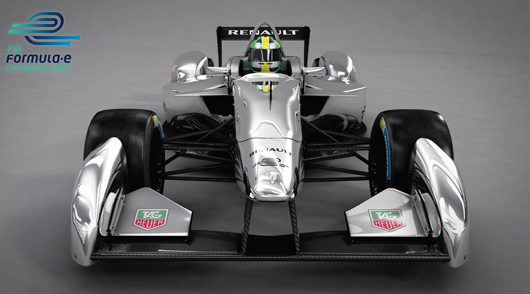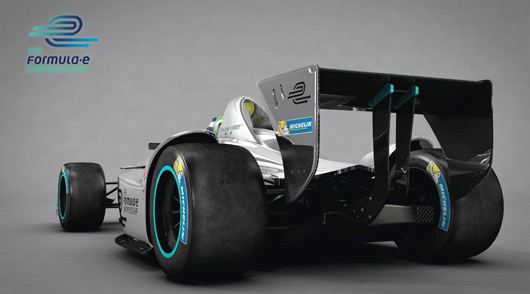In 12 months the FIA will launch its Formula E racing series. For the first season, at least, this Spark-Renault SRT 01E racecar will be the only car you’ll see in action.
An assortment of 10 teams, with two drivers each, will compete in races held across 10 cities spanning four continents. The inaugural season is scheduled to run from September 2014 through to June 2015.
The Spark-Renault SRT 01E has been supported by many leading names from the motorsport world. Design and assembly has been carried out by Spark Racing Technology and Renault is responsible for the electric drivetrain. Behind the scenes McLaren Electronic Systems has played a role in development and assembly of the powertrain, along with the electronic controls. Williams Advanced Engineering did the battery design while Dallara is responsible for the chassis.
Peak power is capped to 200kW, although during races the cars will be limited to 133kW, with the full power in short bursts available in a push to pass mode. Highlighting the limitations of the current technology drivers will have to pit twice during each race, which lasts for one hour, in order to change cars. Yes, change cars!
During practice and qualifying the cars, which weigh 800kg including the driver, will have the full 200kW available to them. Qualifying will consist of just two timed laps per driver.
While wishing the FIA all the best with this Formula E, we’re expecting it to have quite a few teething problems while the series matures.
Technical partner to the FIA Formula E Championship – Renault steps into the era of electric motorsport
A leader in electric vehicles with its Z.E. range and boasting unique expertise in motorsport, Renault is entering the new FIA Formula E Championship. The ten teams racing in the competition, which kicks off in September 2014, will drive the Spark-Renault SRT_01E single-seater, co-designed with Renault Sport and world revealed at Frankfurt.
A new era in motorsport
As a testing ground for new technology, motorsport was bound to embrace electric power sooner rather than later and an initiative from the International Automobile Federation (FIA), the new Formula E competition, is exploring a different path with full-electric, zero-emission single-seaters.
The first Formula E Championship will be held from September 2014 to June 2015. The competition will be organised in ten legs, each one raced in the centre of a major city in Europe (London, Berlin, Rome), Asia (Beijing, Bangkok, Putrajaya) or the Americas (Los Angeles, Miami, Rio de Janeiro, Buenos Aires). For this first season, 20 drivers split up in 10 teams will meet in each race.
Bringing together the biggest names in motorsport
Formula E holdings, instigator of the FIA Formula E Championship, designated Spark Racing Technology to conceive and manufacture the first 40 single-seaters racing. The cars are homologated according to regulations on performance, safety and costs, which means that other carmakers will be able to get involved. To develop the cars and put them into production, Spark set up a consortium featuring the biggest names in motorsport:
- Renault: responsible for the electric drivetrain, system integration, performance optimisation and the safety of the electric drivetrain,
- McLaren Electronic Systems: development, production and assembly of the powertrain and electronic controls,
- Williams Advanced Engineering: battery design,
- Dallara: monocoque design and construction,
- Spark: design of the single-seater (suspension, aerodynamics, assembly).
As Spark’s technical partner, Renault drew on all the skills of the engineers at Renault Sport Technologies and Renault Sport F1 to supervise and optimise the performance and safety of the new car.
Spark-Renault SRT_01E: a concentrate of technology
The Spark-Renault SRT_01E combines the most advanced technologies in electric drivetrains and boasts innovative styling. The vehicle’s aerodynamics were designed to make overtaking easier, while the relatively high ride height was developed for use on the urban circuits in the Formula E Championship. The car meets current Formula 1 regulations.
Like the driver, the battery has its own survival cell. The battery weighs 200 kg and is homologated according to international transport standards. The electric motor delivers 200 kW, or 270 hp, to the rear wheels. Drivers will be allowed to use the full power output of the vehicle in qualifying sessions. During the races themselves, power will be limited to 133 kW, or 180 hp, with a “push-to-pass†mode bringing drivers temporary access to 200 kW (270 hp), the aim being to combine range with overtaking opportunities.
The designers succeeded in limiting vehicle mass to internal-combustion car levels, with the Spark-Renault SRT_01E weighing in at a minimum 800 kg with the driver on board. Performance simulations put the car’s 0 to 62 mph time at three seconds, while top speed is limited to 200 km/h for maximum safety in urban racing.
“We were enthusiastic about this project right from the start because it gave us a chance to explore new paths. No-one had ever designed an electric single-seater with this kind of performance, manufactured in short production runs and developed according to a tight deadline. We factored in a number of constraints, including mass, safety and thermics. Harnessing the complementary skills of the consortium members, the Spark-Renault SRT_01E is an excellent synthesis of current knowledge. We are sure that it will prove to be a stand-out single-seater in motorsport history.â€
François Champod, motorsport technical director at Renault Sport Technologies and Formula E coordinator at Renault


One reply on “Frankfurt 2013: Spark-Renault SRT 01E”
[…] point of difference is the car being used, the Spark-Renault SRT 01E, runs solely on electric power. Formula E lays claim to being the first global zero emissions […]